Vol. 5 No. 27 TROPIC LIGHTNING NEWS July 20, 1970
Index
Arty to the Rescue
Dragons Defend FSB
By SP4 RICHARD ERICKSON
FSB BYRD -- Bravo Company, 2nd Battalion, 14th Infantry, "Golden
Dragons," with accurate artillery support, recently turned back an NVA assault
here and inflicted heavy casualties on the attackers, killing five.
"At about midnight, we began to take a heavy barrage of mortar and
small arms fire from three sides," said First Lieutenant Sam Hargrove, of
Buffalo, N.Y., the company's forward observer. "It seemed like they were
using our radio antenna for an aiming point."
Charlie Battery, 2nd Battalion, 77th Artillery, quickly responded
by pumping 105mm rounds directly into a nearby woodline.
"We couldn't see where they were exactly," said Private First Class
Fred Sundermier, of Palmyra, N.J., "but from the firing we knew they were real
close."
Although enemy fire was heavy, the GIs stayed cool.
Specialist 4 Terry Groud, of Jay, Okla., and Private First Class Tom Heavilin,
from Saybrook, Ill., had to dismantle two M-60s during the intense combat in
order to make one workable. They then shredded the woodline with lead.
Meanwhile, Sergeant Terry Zych, Plymouth, N.H., was busy dropping
rounds into a mortar tube when a dud shell cut through the RPG screen and landed
near him.
"I dropped in the mortar rounds twice as fast after that," said
Zych.
"Some snipers crawled to within a hundred meters of us but we
messed them up with some M-79 rounds," said Private First Class Greg Stitt, of
Salt Lake City.
Evidently realizing further action would be futile, the enemy
withdrew. A recon of the area later revealed the enemy's intentions.
In a nearby trench, matted down grass indicated that a force of about 35 NVA had
been about to make a dash for the wire. It never came off because the
American fire had kept them pinned down.
"There were probably about 100 NVA who must have thought they could
take us," said Intelligence Officer, Captain Bennett Jones.
"Arty did a fantastic job," Jones added. "Those guys really put the
max on them, even with all the incoming."
| IT'S LIKE THIS -- Specialist 5 Robert W. Shriver, Alfa Company, 725th Maintenance Battalion, from Maranna, Pa., explains repair of D-7E Dozer to visiting dignitary -- Secretary of the Army Stanley R. Resor. Major General Edward Bautz, Jr., 25th Division commander, is on Secretary Resor's right. (Photo by SGT Derr R. Steadman) |
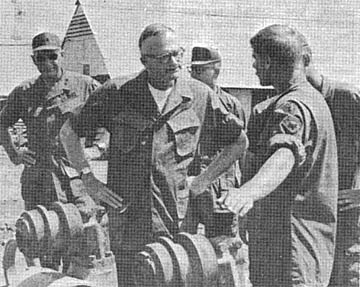 |
Hand-to-Hand Combat
FO Wrestles Attackers
By SP5 DOUG SAINSBURY
BOI LOI WOODS -- "I turned around and through the darkness I could
see two NVA a few meters away preparing to shoot Doc. I didn't have time
to chamber a round, so I ran and dove at them while hollering for Doc to get
away."
Quick thinking and action by Second Lieutenant James W. Roy, from
Newark, Del., of Bravo Battery, 2nd Battalion, 77th Artillery, working as
forward observer for Alfa Company, 2nd Battalion, 27th Infantry, saved the life
of Medic, Private First Class William Braun of St. Louis.
"It was only my second night in the field and I was nervous," said
Roy. "I was with the CP (Command Post) group and we had set up an ambush
patrol in the Boi Lois. We had just gotten set up when it happened."
"It was our shift to sleep, but I was a little tense, so I stayed
awake. Doc was sleeping a few meters to my rear when two NVA stumbled upon
him," Roy recollects.
"When I saw them drop to their knees and take aim on Doc, I knew I
had to do something fast and tackling them seemed the best choice at the time,"
he added.
It turned out to be a wise decision as Roy dove head-first through
a clump of small trees and bowled the two enemy to the ground in football
linebacker fashion.
"I heard Lieutenant Roy holler and as I looked up I saw him land on
the NVA and tumble to the ground," Braun recounted.
"One of their AK-47s smacked me on the head as we all hit the
ground," Roy said. "Then it just turned into a free-swinging fist-fight."
One of the enemy managed to escape, but Roy succeeded in subduing
the other after a lengthy battle.
"I had him in a hammerlock with one of my arms and grabbed his
other arm with my free hand," said Roy. "A few times he managed to get his arm free and
started reaching for his shirt. I thought he might have had a pistol, so I hit him in the mouth
every time he got his arm loose. As it turned out, he had two Chi-Com grenades in his shirt, but
he never got a chance to use them."
"Being an artilleryman, I never expected to have such close contact
with the enemy, especially after being here only two days," he said. "I'm
just glad that I hit them squarely with my tackle so they couldn't fire at Doc."
GI Displays Pride
FSB SWORD -- For one 25th Division infantryman, making containers
for artillery powder charges back in the world was a "Family Affair."
Before entering the service, Specialist 4 Harold Olsen of the 2nd
Battalion (Mech), 22nd Infantry, worked at the Conco Engineering Company in his
home town of Mendota, Ill. The company builds containers to protect powder
charges for artillery rounds.
"The funny thing about it is that practically my whole family works
there," said Olsen, "four aunts, one uncle, two cousins, my mom and I."
Some of the Olsens man the company's assembly line.
"One of my aunts welds the seam of the canisters. My uncle
and two other aunts spot weld them. My mom welds the outer ring of the
canisters, and another aunt pressurizes the lids to the canisters," continued
Olsen.
Now at the Triple Deuce forward position, Olsen often sees his work
put to use. One night, for example, his battalion came under enemy attack.
With the help of an artillery battery the enemy was soon turned away.
"Little did I think back then that the ammo my family helps make
would one day save my life," Olsen said.
 |
| SEARCH AND CLEAR -- Men of the 2nd Battalion (Mech), 22nd Infantry, blast away at a suspected enemy complex west of Thien Ngon. (Photo by SP4 Henry G. Zukowski) |
Page 2 TROPIC LIGHTNING NEWS July 20, 1970
Decorated
| SILVER STAR | |
|
LTC Nathan C.. Vail, HHC, 2d Bn, 22d Inf SGT Thomas W. Shepherd, HHC, 2d Bn, 34th Armor |
SP4 Michael Goertz, Co B, 4th Bn, 23d Inf PFC Ronald J. Marler, HHC, 2d Bn, 34th Armor |
|
DISTINGUISHED FLYING CROSS |
|
| CPT Robert C. Lockwood, 25th Avn Bn | |
|
BRONZE STAR |
|
|
CPT Wilfred L. Dellva, Co B, 2d Bn, 34th Armor CPT Richard D. Eye, HHC, 2d Bn, 27th Inf CPT Julius Keller Jr, Co A, 3d Bn, 22d Inf CPT Robert L. Schmidt, Co C, 4th Bn, 23d Inf 1LT Stephen Candela, Co C, 3 d Bn, 22d Inf 1LT Philip E, McBahan, A Trp, 3d Sqdn, 4th Cav 1LT Charles Mead, A Btry. 1st Bn, 8th Fid Arty 1LT David L. Myers, 25th MP Co 2LT Philippe C. Dean, Co C, 3d Bn, 22d Inf 2LT John S. Jacoby, A Btry, 1st Bn, 8th Fld Arty WO1 Ira J. Boyea, Co A, 25th Avn Bn WO1 Kenneth Thiem, HHC, 3d Bde WO1 Donald W. Usher, Co A, 25th Avn Bn 1SG Arthur F. Lyman, A Btry, 1st Bn, 8th Fld Arty SFC Francisco Fernandez, A Btry, 1st Bn, 8th Fld Arty SSG James E. Cameron, Co A, 2d Bn, 34th Armor SSG Chester C. Dowling, A Trp, 3d Sqdn, 4th Cav SSG Coy R. Jackson, Co A, 2d Bn, 34th Armor SSG Dennis L. Stultz, Co A, 2d Bn, 27th Inf SSG James H. Wilson, A Trp, 3d Sqdn, 4th Cav SGT Jess E. Anderson, A Btry, 1st Bn, 8th Fld Arty SGT Richard L. Armstrong, A Trp, 3d Sqdn, 4th Cav SGT Byrle W. Dorrand Jr, Co D, 2d Bn, 27th Inf SGT Henry P. Flores, Co A, 4th Bn, 23d Inf SGT Daniel B. Gallegos, A Btry, 1st Bn, 8th Fld Arty SGT Dennis E. Killean, Co A, 4th Bn, 23d Inf SGT Curtis G. Lemay, C Btry, 7th Bn, 11th Fld Arty SGT Perry Lynch, Co A, 4th Bn, 23d Inf SGT Michael Marcum, Co C, 3d Bn, 22d Inf SGT John McCubbin, Co B, 4th Bn, 23d Inf SGT Melville C. Pickett, Co B, 2d Bn, 14th Inf SGT Robert J. Proefrock, Co A, 4th Bn, 23d Inf SGT Fredrick Rzempala, A Trp, 3d Sqdn, 4th Cav SGT Keith S. Sadowski, Co A, 4th Bn, 23d Inf SGT Michael T. Shima, Co A, 4th Bn, 23d Inf SGT Donald A. Shoulders, Co A, 4th Bn, 23d Inf |
SGT Larry J. Simpson, Co C, 3d Bn, 22d Inf SGT Clark E. Slothower, Co C, 3d Bn, 22d Inf SGT Steve M. Tamura, Co A, 4th Bn, 23d Inf SGT John A. Taylor, Co A, 4th Bn, 23d Inf SGT Bruce G. Tindall, A Trp, 3d Sqdn, 4th Cav SGT Dale A. Vick, Co A, 2d Bn, 34th Armor SGT Edward Wilson, Co B, 4th Bn, 23d Inf SGT Terry W. Zych, Co B, 2d Bn, 14th Inf SP4 Lester Lee Beaty, A Trp, 3d Sqdn, 4th Cav SP4 Kenneth D. Bouey, C Trp, 3d Sqdn, 4th Cav SP4 Walter W. Bryan, Co A, 4th Bn, 23d Inf SP4 Ronald G. Brune, Co A, 2d Bn, 27th Inf SP4 Edward O. Bruckman, Co A, 2d Bn, 27th Inf SP4 Paul Calvacca, Co A, 4th Bn, 23d Inf SP4 Tommy Cartrette, Co A, 4th Bn, 23d Inf SP4 Garry Chadwell, Co B, 2d Bn, 14th Inf SP4 Robert E. Cook, Co A, 4th Bn, 23d Inf SP4 Roy F. Cooper Jr, Co A, 4th Bn, 23d Inf SP4 Paul D. Crug, A Trp, 3d Sqdn, 4th Cav SP4 Wayne E. Fruman, Co D, 2d Bn, 22d Inf SP4 Jack A. Green, Co B, 2d Bn, 27th Inf SP4 Keith G. Gregory, Co A, 2d Bn, 27th Inf SP4 James L. Hackler, Co D, 2d Bn, 34th Armor SP4 William Jones, Co A, 4th Bn, 23d Inf SP4 Jimmy Lawson, Co B, 4th Bn, 23d Inf SP4 Michael MacDonald, Co E, 2d Bn, 27th Inf SP4 Lillard B. Manning, Co C, 3d Bn, 22d Inf SP4 William F. Marshall, Co A, 4th Bn, 23d Inf SP4 Garry W. Miller, A Trp, 3d Sqdn, 4th Cav SP4 Robert G. Nichols, Co B, 2d Bn, 14th Inf SP4 Terrence J. O'Brien, Co A, 4th Bn, 23d Inf SP4 Michael Pasowicz, Co C, 3d Bn, 22d Inf SP4 Stan J. Przybylinski, Co A, 4th Bn, 23d Inf SP4 Gregory D. Pyban, Co A, 25th Avn Bn SP4 Joseph R. Reynolds, Co A, 25th Avn Bn |
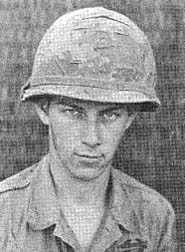 Timely Initiative
Timely Initiative
Manchu Makes Honor Roll
CU CHI -- Specialist 4 John P. Schaad has been added to the Tropic Lightning
Combat Honor Roll.
SP4 Schaad distinguished himself by heroic actions on May 28, serving with
Company D, 4th Battalion, 9th Infantry. While on a reconnaissance operation,
elements of his company came under attack from a large enemy force. In the
initial contact, all unit leaders became casualties. Responding to the absence
of leadership, SP4 Schaad organized efforts to remove the wounded.
Without regard for his own safety, SP4 Schaad exposed himself to a hail of
small arms fire, automatic weapons, and rocket propelled grenade fire as he
moved through the contact area, distributing ammunition and encouraging his
men. When evacuation of the wounded proved almost impossible because of the
intense enemy fire, SP4 Schaad suggested the successful idea of using a smoke
screen to provide cover for his wounded comrades as they were evacuated.
Fires: Still A Concern
Blankets and mats,
Unlike flaming desire,
Aren't much fun
When they light your fire.
"The problem and hazard of fires is always present, and the wet season is no
exception," reports civilian Ralph C. Neves, of Wilmington, Ill., division
safety director.
There is an ever present concern for the chance of a fire flaring up in the
living quarters at any base camp, because of extremely flammable building
materials and close quarters. No precaution should be over looked.
The use of bamboo matting, blankets, cloth and other flammable or smoke
producing materials as wall coverings and dividers, besides being against Army
Regulation 420-90, para 35b, is also extremely hazardous in so far as fire is
concerned.
Even though many articles may not burn they still may produce smoke which
could cause suffocation and could smolder spreading flame flammable articles,
causing a major fire.
Though few recently reported fires can be directly attributed to flammable
wall mats and dividers, it is known that they increase the spread of a fire
once started.
It is also known that the prime causes of most fires in living quarters are
overloaded electrical circuits and smoking in bed. Recently a serviceman on R&R
died from smoke suffocation when he fell asleep with a cigarette in his hand.
But the immediate concern is where fire affects the most lives - in living
quarters at base camps. If precautions are taken, fires will be kept to a
minimum. It is easier to prevent a fire than to put one out.
| WEST POINT GRAD - Lieutenant Colonel Forrest T. Gay III, has assumed command of the 65th Engineer Battalion. LTC Gay comes to the division from the U.S. Strike Command, MacDill AFB, Fla. This is his second tour in Vietnam. |
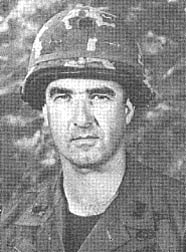 |
Tropic Lightning Tots
The Commanding General Welcomes
The Following Tropic Lightning Tots
To The 25th Infantry Division – As
Reported By The American Red Cross.
Born To:
| June 20 SP4 William H. Eplett, HHT 3d Sqdn, 4th Cav, boy June 26 PFC Robert Weugert, Co D 5th Med, girl June 28 WO1 John W. Sharp, HHC 1 Bde, boy SGT Emery Robinson, 579th Sig Co, girl June 29 SP4 Michael Lovell, 587 Sig Bn, girl |
June 30 PFC Dennis Hilger, Co B 4th Bn, 9th Inf, boy SP4 John M. Lanier, Co D 588 Eng. Bn, girl July 1 SP5 Peter R. Young, Spec Svcs Lib, boy July 2 SP5 Allen W. Hunt, HHC 588th Eng Bn, girl |
The TROPIC LIGHTNING NEWS is an authorized publication of the 25th Infantry Division. It is published weekly for all division units in the Republic of Vietnam by the Information Office, 25th Infantry Division, APO San Francisco 96225. Army News Features, Army Photo Features, Armed Forces Press Service and Armed Forces News Bureau material are used. Views and opinions expressed are not necessarily those of the Department of the Army. Printed in Tokyo, Japan, by Pacific Stars and Stripes.
MG Edward Bautz, Jr . . . . . . Commanding General
MAJ Warren J. Field . . . . . . Information Officer
1LT John Caspari . . . . . . . . . Officer-in-Charge
SP4 Bert Herrman . . . . . . . . . Editor
SP4 Scott Watson . . . . . . . . Assistant Editor
SP4 Joseph V. Kocian . . . . . Production Supervisor
BATTALION CORRESPONDENTS
| SGT Mike Keyster SP4 Tom Benn SP4 Frank Salerno SP4 Henry Zukowski PFC Robb Lato SP4 Greg Duncan SP4 Rich Erickson SP4 Ed Toulouse SGT Mike Conroy SP4 Dan Davis |
4/23 7/11 2/22 2/22 2/27 2/27 2/14 2/12 3/4 Cav 1/27 |
SGT William Zarrett SP4 George Graham SP5 Tom Watson SP4 William McGown PFC James Stoup SGT Derr Steadman SP5 Doug Sainsbury SP4 James Duran SGT Jack Strickland |
4/9 269th 725th Divarty 65th Eng Discom 2/77 3/13 1/27 |
Page 3 TROPIC LIGHTNING NEWS July 20, 1970
Extending East
S-5 Battles For Minds
By SP4 RICH WERNER
KATUM - When a man's home is destroyed and his wife and children are hungry,
what can he do?
The problem was common to Cambodians living near here and the First Brigade
civic action section set out to help solve it by moving operations lock, stock
and barrel across the border.
The section traveled on the heels of maneuver elements setting up MEDCAPS
and distributing captured enemy rice, corn oil, flour, wheat and oats among
Cambodians.
"Initially, they (the Cambodians) were wary of us," 1st Lieutenant Thomas
Johnson, New York, said. "But soon they were amazingly grateful for our help."
Assisted by the 2nd Civic Action Unit the brigade section set up a program to
provide material and guidance to Cambodians who lost property because of the
fighting and tried to get them back on their feet again.
They also tackled the refugee problem.
"Daily 190 to 250 people were returned to Cambodia," Johnson said. "Most
were taken to Memot because it's most centralized."
Other were delivered directly to their homes if a convoy was headed in the
right direction.
"It's very easy for members of families to get separated. We did our best to
prevent this sort of thing," Johnson said.
At the same time the section conducted regular psychological operations.
Chieu-Hoi (Open Arms) leaflets were dropped from aircraft and loud speaker teams
operating with maneuver elements made broadcasts during ground operations.
"We emphasized that the enemy was hurting for supplies and tried to create
doubt and insecurity and weaken morale among them," Johnson said.
Ralliers were interviewed and asked to make statements that could be used in
making new leaflets and recordings. They testified to being well treated by the
allies.
"It's of utmost importance to keep the civilian population informed," Johnson
said. "We used posters, leaflets and broadcasts for that purpose, too."
"There isn't any justifiable criteria for evaluating our work because we're
dealing with men's minds," Johnson said. "About the most tangible thing we have
are the GIs returning from the field carrying those delicious looking
pineapples. More than likely each one was a present from a villager."
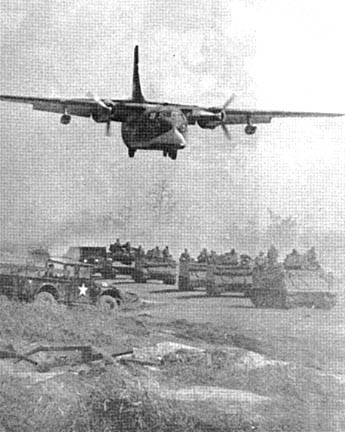 |
HOMECOMING -- Tropic Lightning troops return to Thien Ngon after operations in Cambodia, aboard Armored Personnel Carrier and C-123. (Photo by Henry G. Zukowski) |
GI Dogs Inspire Odd Tags
"Spot", "Rover", and "Fido" - Are names long typifying the "All American
Dog". However, GIs in Vietnam, breaking with the "establishment", have given
their canine buddies a new set of call signs. Many of the following names
reflect attitudes, situations, and surroundings typical in O.D. Vietnam:
"Claymore", "Didi", "2/12", "Boom Boom", "Melon Head", "Trip" "Ranger",
"Faith", "Bush", "Dooper", "Maurice", "Speed" "Cool Breeze", "Zero", "Red
Baron", and "Handset."
The canine "friendlies" are simple in their tastes and live in relative
comfort on C-rations and table scrapes. What's more they are easy to get along
with. As for the war, they couldn't care less.
Busy Engineers
Watering Point
BY PFC JAMES D. STOUP
CU CHI - Wetting the whistle of the 65th Engineers is the job of Sergeant
Jackie Grass, Locust Grove, Okla., and the men of the battalion logistics
section.
Each day Grass and his crew obtain, purify and deliver up to 40,000 gallons
of water to the engineer troops.
"In the field we pump the water from rivers and streams into 1,500 gallon
van-mounted water purification units," Grass said. "It's filtered there."
"Then, using a highly technical system and variety of chemicals, the water is
cleaned of bacteria, color, taste and odor. This system produces from 9,000 to
10,000 gallons of water per day."
Back in the base camp the engineers who man the water point go through the
same process but their purification unit is housed in a permanent water shed.
It purifies about 1,500 gallons of water per hour for 16 hours each day.
The water is pumped directly to various units in the rear area.
"Wherever our men go, we're not far behind," Grass said. "Water is as
important and necessary to the soldier in the field as his weapon."
|
Ready-Aim-Fire |
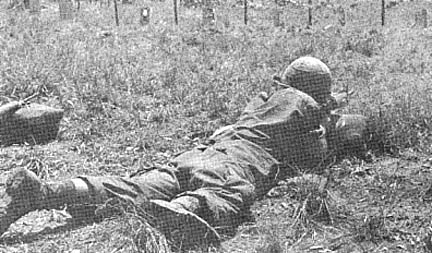 |
| BANG, BANG - Triple Deucer zeroes his M-16 at 2nd Battalion (Mech), 22nd Infantry, rifle range at Fire Support Base Sword. (Photo by Henry G. Zukowski) |
|
Utaloski Commanding Division's Second Bde THIEN NGON - Making his third tour to Vietnam, Colonel Joseph R. Ulatoski recently took command of Tropic Lightning's 2d Brigade. Colonel Ulatoski, of Stamford, Conn., assumed command from Colonel Waldon Williams, of Alexandria, Va., who has returned to the 3rd Brigade, 9th Infantry Division. On his first tour in 1964-65 Colonel Utaloski was G-3 advisor from the 2nd Vietnam Corps. He came back again to assume command of the 1st Division's 2nd Battalion, 16th Infantry in July of 1967. Prior to assuming command of the Second Brigade, Colonel Ulatoski was military assistant to the Under Secretary of the Army. |
Convoy Rolls Thru Ambush
By SP4 RICH ERICKSON
FSB BYRD - An enemy ambush failed to stop a determined "Golden Dragon" resupply convoy recently as it made it's way to Fire Support Base Byrd.
The seven vehicle convoy from the 2nd Battalion, 14th Infantry, was passing
thick woods near a narrow road when the enemy opened up with rocket propelled
grenades (RPGs) and small arms fire.
Specialist 4 Steve Cramer was driving a deuce-and-a-half loaded with
ammunition for Charlie Battery, 2nd Battalion, 77th Artillery. "All of a sudden
there was a huge explosion near the truck and I almost swerved off the road,"
Cramer said. "I down-shifted and put my foot to the floor because I didn't want
the ammo to be a sitting duck."
"I was in a jeep up ahead and after the explosion we began to receive small
arms fire from the woodline but continued to roll at top speed," added Charlie Battery First
Sergeant, Richard Collins.
The entire convoy made it to Byrd intact, although not without some damage.
The ammo truck, for instance, sustained numerous shrapnel holes, five flat
tires, and a punctured gas tank. But, thanks to a quick-thinking, driver, it
kept rolling and no one was injured.
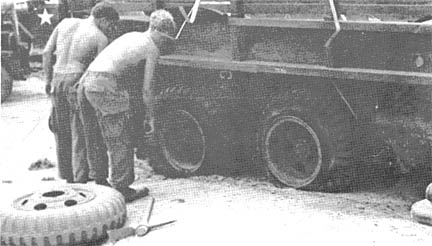 |
VERY FLAT -- Specialist 4 Steve Cramer of Charlie Battery, 2nd Battalion, 77th Artillery, surveys damage to his truck after being hit with an RPG in an ambush en route to Fire Support Base Byrd. (Photo by SP4 Rich Erickson) |
Page 4-5 TROPIC LIGHTNING NEWS July 20, 1970
FREE TIME: REST AND FUN SQUEEZED BETWEEN THE ACTION
Men of Alfa Battery, 7th Battalion, 11th Artillery and Charlie Company 4th Battalion (Mech), 23rd Infantry, find a few minutes to 'take five.'
|
Photos by |
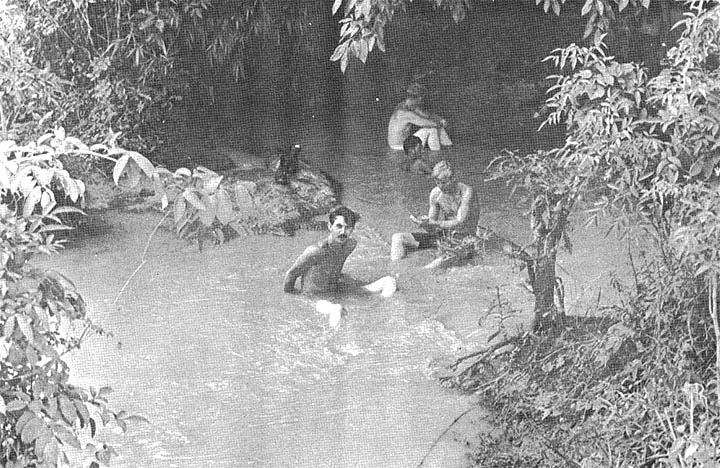 |
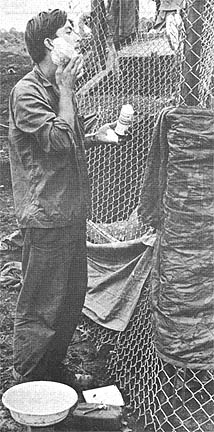 |
|
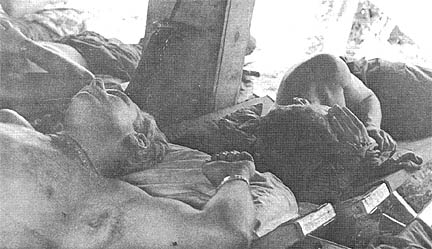 |
|
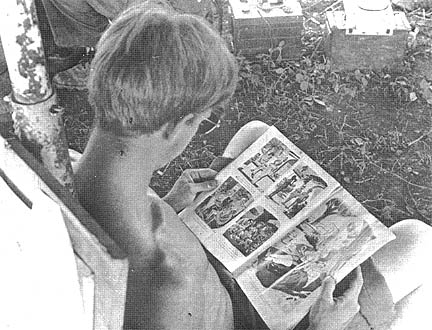 |
|
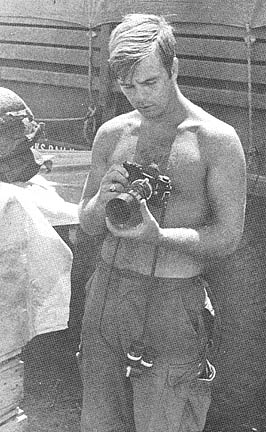 |
|
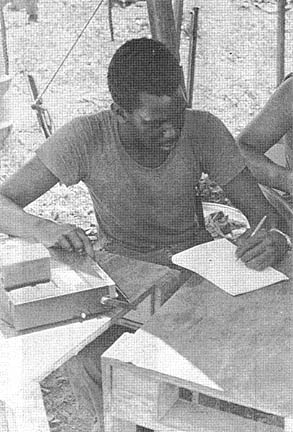 |
Page 6 TROPIC LIGHTNING NEWS July 20, 1970
Comedy of Errors
Marriage Plans Altered
By SP5 DOUG SAINSBURY
CU CHI -- Marriage on a Hawaiian R&R is a great idea, but for Specialist 4
John Yohler, an operations assistant with Headquarters and Headquarters Battery,
2nd Battalion, 77th Artillery, it was a harrowing experience he could sell as a
Hollywood movie script.
"My fiancee and I had originally planned to marry before I came over here,
but decided against it," relates Yohler of Marion, Ind., "In our letters, we
discussed the possibility of getting married in May while on Hawaiian R&R.
"I wrote to a priest, Father Henry Sabog, at the Cathedral of Our Lady of
Peace in Honolulu, and he replied that he would be happy to perform the
ceremony."
Yohler's fiancée, Miss Susan Dawson of Indianapolis, arrived in Hawaii two
days early to make all the final arrangements. That's when Yohler's troubles
started.
"Problems began when my plane was delayed for five hours in Guam," recalls
Yohler, "We had planned to have the wedding late that afternoon, May 13th. All
I could think of while waiting for the plane was that the situation was
hopeless. I figured we would have to wait another day or two."
What the nervous bridegroom didn't know was that Father Sabog had been called
to another island for 30 days on emergency. Miss Dawson made a quick change of
plans with the Monsignor of the Cathedral, who said he would perform the
ceremony if Yohler could be there by 6 p.m. that evening. The young bride-to-be
contacted friends on the island to be witnesses and informed them of the change
of plans.
Yohler arrived at the R&R Center at Ft. DeRussy at 5:30 p.m. -- in time to
discover that the marriage license bureau had closed at 4 p.m.
"The Chaplain at the R&R Center told us that there was a lady in town
authorized to issue licenses, so we rushed over to her home. She was about to
leave for a meeting and had a pot of beans cooking on the stove, which she was
going to take with her.
"She was worried about her beans and we were worried about our wedding.
Finally we worked it out and she issued us a license.
"Then we drove, to the Church and found no one in the office because it was
after 6 p.m. In a few minutes, we found Father Albert Meinsinger in another
part of the building. He told us that the Monsignor had asked him to marry us
since the Monsignor was busy," Yohler continued.
"But the witnesses had left, so we were still in a bind. We drove around
looking, but couldn't find them."
John and Sue returned to the church, and when at 8 p.m. the witnesses came
back, the vows were finally exchanged.
"It seemed like a nightmare at the time, but after it was over, we all had to
laugh about it," recounted the groom.
"They say that your Wedding day is one of the most meaningful and exciting
days of your life, but that is an understatement for Sue and I."
It Means 'Nothing'
Or Does It
By SP4 ED TOULOUSE
VIETNAM - At some time or another during his tour, the average GI in Vietnam
realizes that something about him has undergone a change -- one much deeper than
his dirt-embedded tan or sun-bleached hair. The change is in outlook. More
specifically, in his ability to cope with everyday difficulties in Vietnam.
The "new guy" in country with his pale skin, new jungle fatigues, and
stateside airs becomes hardened both in attitude and appearance.
The veterans, whether they have two or eleven months in country, seem to
share an attitude best typified by the often repeated claim, "It don't mean
nothing."
Whatever the problem - whether it be the loss of a poncho liner, sleeping in
the rain or receiving a "Dear John" letter -- it can usually be rationalized
with, "It don't mean nothing."
What is there in this grammatically incorrect phrase that makes it so
meaningful? Possibly it's the acceptance of hardship in the realization that in
less than a year this will all seem a bad dream.
Uninvited Guests Get Cold 'Hello'
By SGT JACK STRICKLAND
THIEN NGON -- Two NVA who came calling on an ALFA company 1st Battalion, 27th
Infantry day lager site near here recently, were quickly met at the gate by an
"unwelcoming" committee.
"We were just sitting there when these two NVA walked around the corner and
stopped about ten feet from us. One was reading something, and when they looked
up they were as surprised as we were," recalled Specialist 4 Agapito Martinez,
of Brownsville, Tex.
Recovering from their surprise, Specialists 4 Josue Sallas, of Puerto Rico,
and Jerry James, of Oklahoma City, Okla., were the first to engage the enemy
soldiers, killing one.
A subsequent search of the area turned up one RPG rocket propelled grenade
launcher, three B-40 rockets with extensions and some vegetables.
New Guy in Artillery
Gun Bunny -- No Rabbit
By 1LT MARTIN E. WEBB
FSB CROOK - "Gun bunny, yeh, same-same new guy; it's the first step on the
gun."
This is the way gun bunny Private First Class Randy Culwell of Los Angeles
explains it. PFC Culwell is a member of Alfa Company, 1st Battalion, 8th Field
Artillery, "Automatic Eighth," and he works on a 105mm Howitzer.
According to Culwell, when an EM comes to Vietnam with an Artillery MOS, he
usually starts out as a gun bunny. From there, he can work his way up on the
gun and, if he's good enough, he'll make "number one man."
A gun bunny fills sand bags and humps ammo. "As many times as we move,"
Culwell says, "It gets to be a pretty busy job and pretty tiring.
"Each time we move, we have to build two ammo bunkers and one personnel
bunker. Everything must have two layers of sandbags, and the splash wall must
be six or seven bags high."
After gun bunny, the next step on the line is cutting charges. Each
artillery round has a maximum amount of charges on it and some have to be
removed, based on the calculations for the desired range of that round.
"From there," Culwell explains," you start setting fuses on the rounds, then
if you're doing a good job, you'll progress to 'number one man' -- the guy who
does the actual loading."
As the gun is being prepared for fire, the professionals take over. The
assistant gunner sets the quadrant, determining the range. The gunner sets the
deflection, aiming the gun to the left or right. The section chief checks
everything. Then the assistant gunner pulls the lanyard and it's "on the way."
As an artilleryman rises in position he can expect promotion in rank also.
Gun bunnies usually start as privates first class. By the time a man is setting
fuses or number one man he can expect to be Specialist 4. Most gunners and
assistant gunners are E-5's.
So, as Automatic Eighth gun bunnies pick up the tricks of their trade, the
big guns loom before them with promise of promotion and advancement.
| Ilikai East by Night WED Floor Show (6 p.m.) THU Monte Carlo (8 p.m.) FRI Cookout on Patio (8 p.m.) Officers Coffee Call (8 p.m.) SAT Tournaments (2 p.m.) Movie and Popcorn (7:30 p.m.) SUN Coffee Call (10 p.m.) Tournaments (2 p.m.) Bingo (8 p.m.) MON Summer Ice Cream Party (8 p.m.) TUE Wagon Wheelers Round-up Dance |
Ask Sgt. Certain
DEAR SGT CERTAIN: We're out of Cambodia now. Do you think we'll ever return
there?
SPEC Kled
DEAR SPEC: I doubt it, but there's murmuring among the command sergeants major
that they want to go back for a police call.
DEAR SGT CERTAIN: I have noticed some large bugs that look like crickets
gathering wherever there is a light in the evening. I have never seen a bug so
big. What do the Vietnamese do with them.
Wondering
DEAR WONDERING: For an answer I went to Mama-San. She said that in the
beginning of the rainy season they are big enough for you to eat them. By the
end of the rainy season they are big enough to eat you.
Page 7 TROPIC LIGHTNING NEWS July 20, 1970
52 Days at 12th Evac
Cambodian Girl Returns Home
CHIPHU, Cambodia - U.S. forces recently returned an 18-year-old woman to her
home in Cambodia after treating her at their medical facilities and probably
saving her life.
Mrs. Ninh Yan was one of almost 50 Cambodians evacuated by 25th Division
troops and treated at American hospitals during operations in Communist
sanctuaries. She had been wounded as she and her family walked across a field
and were caught in a firefight.
"She was a very cooperative patient even though we had a language barrier at
first," said Captain Diana Kerns, of Fairmont, W. Va., one of the nurses who
cared for Ninh. "All the Cambodian patients were very cooperative.
"They really tried to help. They seemed to appreciate everything we did for
them," she added.
The Cambodian patients were treated at the 12th Evacuation Hospital and the
45th Surgical Hospital or turned over to Vietnamese hospitals.
"Many of the Cambodian patients have been returned to their homes through the
GVN (Government of the Republic of Vietnam) refugee centers or through the units
which originally brought them in," said Captain A. Marc Christianson, Civil
Affairs Officer for the 25th Division.
"They got the same treatment we give our own GIs," Christenson added.
Ninh had been wounded in the leg and stomach. She probably would have died
without treatment, according to her doctors.
"She was very tolerant of pain. When she was able to get up she would help
other patients. She always smiled and seldom complained even though hers were
particularly painful injuries," Captain Kerns said.
Shortly before Ninh returned to her home, she was given a gift as were most
of the other Cambodian patients. The money is given in accordance with oriental
custom as "an expression of our sympathy," said Christenson.
After 52 days in the hospital at Cu Chi, Ninh boarded a 25th Division chopper
with an interpreter and Christenson and was flown to her village.
There she was met by her brother and an aunt. She learned that seven members
of her family had been killed in the fighting in that section of Cambodia. But
she knew that the Americans had tried to help her.
She gave the interpreter and Christianson gifts before they returned to Cu
Chi. "If ever you can visit me again, you will be welcomed," she told the
interpreter.
|
Photos and Story By Charles C. Self |
| Helping wounded Cambodians regain full use of their bodies was part of the contribution of 25th Division medical facilities. Here Specialist 4 Francis A. Ramella helps Ninh excercise her wounded leg. |
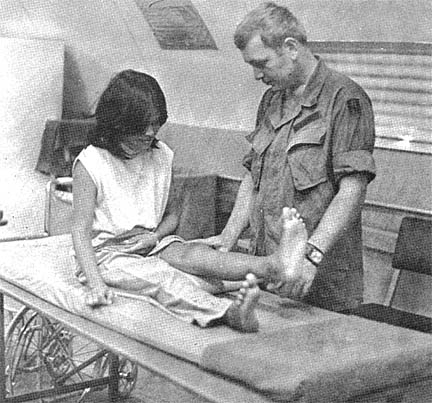 |
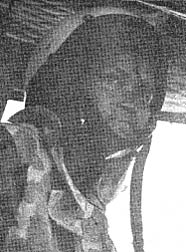 |
The day came. She climbed aboard a chopper for home. |
| Ninh had to learn to walk again after weeks in 12th Evacuation Hospital. Here 1st Lieutenant Juoi Tracy and Civil Affairs Officer Captain A. Marc Christianson help her practice. |
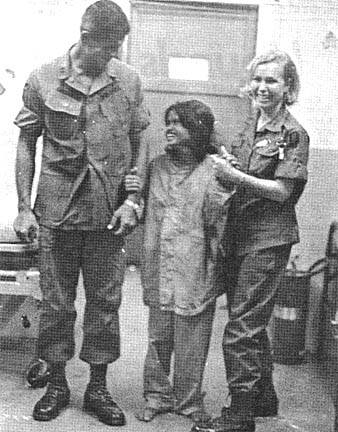 |
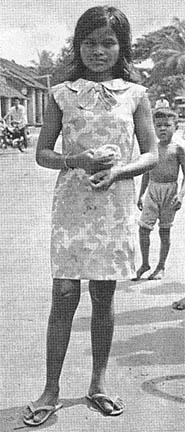 |
Ninh Yan was one of almost 50 Cambodian civilians who were treated by 25th Division medical facilities during operations there. |
| Ninh was met by her brother. He led her to her new home after she returned from Vietnam. |
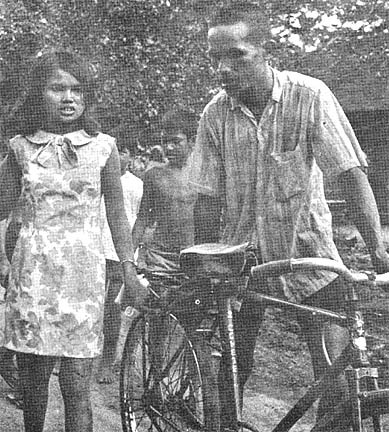 |
Page 8 TROPIC LIGHTNING NEWS July 20, 1970
Cordon and Search
Hounds Route Charlie
By SP4 ROBB LATO
CU CHI - "It was a delicate operation. Whenever you send troops into an area
where there are innocent civilians and suspected VC hiding places, you really
have to be careful," said Captain David Howery, of Columbus, Ga.
Howery, Commander of Bravo Company, 2nd Battalion, 27th Infantry
"Wolfhounds," was talking about the recent cordon and search of Bau Dieu Hamlet,
three miles northwest of here.
Complaints from the Vietnamese people, combined with the recent assassination
of the hamlet chief provoked the plan for the mission.
"We heard from the RFs (Regional Forces) that many of the villagers had
spotted several VC suspects in the area. After talking with the RFs and PFs
(Popular Forces), it was decided that a combined operation was the best way to
help the villagers," added Howery.
The Wolfhounds moved Alfa and Bravo companies into holding positions late in
the afternoon. After nightfall, the Hounds began moving toward their blocking
positions.
"We were about 1,000 yards away from our positions when we heard the RFs open
up. After we heard the contact, we moved rapidly into our blocking positions to
prevent enemy from entering or leaving the hamlet," explained Specialist 4 Dean
Lowman, a Wolfhound medic from Atlanta, Ga.
"It was near dawn when we killed a VC trying to slip through out lines," Alfa
Company platoon sergeant, Staff Sergeant Dennis Stultz, from Hagerstown, Md.,
said.
"Soon after sun-up, the RFs entered the hamlet in search of more VC," added
Stultz.
'Chieu Hoi' Shout VC
By SP4 RICH ERICKSON
DAU TIENG - A road sweep team captured two frustrated Viet Cong soldiers
during a recent operation near here.
"We were almost on top of two Viet Cong before we spotted them coming out of
the woods," recalled a soldier from Alfa Company, 2nd Battalion, 14th Infantry.
"Without any hesitation, they threw up their arms and shouted 'Chieu Hoi'."
Later, at Dau Tieng, they were questioned by Intelligence personnel. ARVN
Staff Sergeant Huynh Tau Buu, an interpreter, spoke in a friendly manner to put
the two bewildered ralliers at ease.
"At first, neither one would speak," he said "but my interpreter kept talking
and joking with them. We gave them a good meal, and one indicated that his wife
lived in a nearby village. It was quite a happy reunion when we brought her to
him."
"After that," Edwards continued, "the rallier began to talk freely. He told
us they had just come from Cambodia in an unsuccessful attempt to get rice and
supplies, evidently because of the recent allied operation there.
| HARD WORK - Triple Deuce mechanics, "Maniacs," replace a worn engine from a tracked 548 vehicle. (Photo by Henry G. Zukowski) |
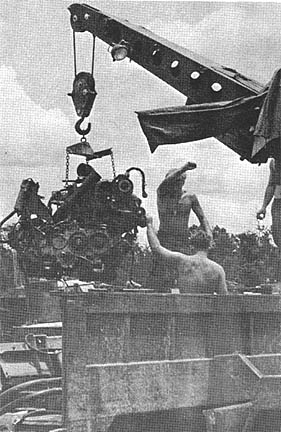 |
2/22 Mechanics
'Maniacs' Rule
By SP4 HENRY G. ZUKOWSKI
CU CHI - Reports have circulated recently that a bunch of "Maniacs" have
taken over the Triple Deuce armored personnel carriers.
The "Maniacs", however, are actually the mechanics of the 2nd Battalion (Mech),
22nd Infantry.
When "Triple Deuce" tracks return from the field the mechanics work
around-the-clock repairing and replacing damage.
Problems
"The biggest problems our APCs run into out there are enemy mines and rocket
propelled grenades," said Chief Warrent Officer Billy Shambilin of Charleston,
W. Va., battalion motor officer.
The repair jobs start with the company mechanics who keep the tracks going
during combat operations until the APCs can reach battalion mechanics for more
thorough maintenance.
"Changing road wheels, shock absorbers, wheel seals and bearings are just a
few of the minor repairs done by the company mechanics," added Shambilin.
Diagnosis
After receiving a damaged track, battalion mechanics inspect and determine
the cause of the trouble. Working with the 725th Maintenance Battalion, further
inspection is given to double check the cause.
Once the APC has cleared 725th Maintenance, the Triple Deuce mechanics go to
work.
"Electrical wiring, charging systems and engine trouble are our biggest
problem," said Specialist 4 Jim Ruckas of Omaha, Neb.
"We can pull out a worn engine or blown pack within an hour," said Specialist
4 John Mehling, of Evensville, Ind., a battalion mechanic.
Like Mad
"Our nickname, the Maniacs, comes from the fact that we work so fast it seems
like we're going mad. Actually, however, we use TLC (tender loving care) on all
the machines," smiled Mehling.
"Make do with what you have," said another mechanic. With the massive
repairs and replacements of parts required during the two month operation in
Cambodia, parts and tools became a luxury.
| STRAINING STRAPS and swinging guns keep the men of 1st Battalion, 8th Artillery, "Automatic Eighth," on their toes as a CH-47 Chinook swings its cargo precariously over Thien Ngon landing pad. (Photo by PFC Rick Connell) |
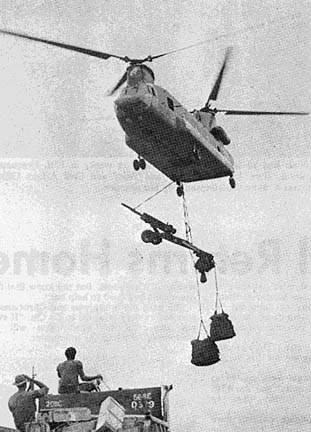 |
TLN Interview: the Weatherman?
By SP4 RICH DOMBROWICKI
CU CHI AIRFIELD - TLN: Pardon me, sir, I'd like to know when the next
fixed-wing leaves for Bien Hoa.
CPT: (Captain Leonard Bucklin, commander, OL-4, 5th Weather Squadron):
Specialist, you're about the one millionth person to come in here asking for
flight information! This isn't the passenger terminal, that's the next building
down.
TLN: Oh, I'm sorry, sir. What is this place anyhow?
CPT: This is the Cu Chi Air Weather Station.
TLN: Um, I guess that accounts for all the maps and charts on the walls. Looks
like a pretty nice set up, air-conditioned and all.
CPT: The air-conditioning is primarily to keep our equipment functioning
properly, especially the teletype machines. We depend on them for sending out
our forecasts and for receiving weather reports from all over the Far East, from
Japan to Thailand to Australia.
TLN: That's cool. But is that all you have? What about a barometer and a
thermometer and stuff like that?
CPT: We keep the barometer in here because, otherwise, the heat would ruin it.
But the thermometer is outside, of course.
TLN: I see. By the way, what's that funny-looking thing out there with the cups
spinning around on a pole?
CPT: That's an anemometer. It measures wind speed and direction. Together with
the barometer (air pressure) and wet and dry bulb thermometer (air temperature)
readings, we keep highly accurate statistics. We take these stats and combine
them with information from the Army's Metro Service (Cu chi), chart them into
maps and send them out via the teletypes.
TLN: Sir, it sounds like your operation here isn't Army.
CPT: No indeed, The Air Weather Service, of which we are a part, is an Air Force
function. It originally started as a part of the Army Signal Corps in 1870.
TLN: Ah, so. Then all you do is forecast the weather for the planes that use
the airstrip here.
CPT: That's only one of our jobs. We're responsible for forecasting the weather
for the entire 25th Infantry Division area of operations, from Long An to Tay
Ninh. Units of the 25th, especially flight and engineer units, constantly call
us for up-to-the-minute advisories (short briefings) on what effect the weather
will have on their operations.
TLN: I guess accuracy is pretty important.
CPT: Most affirmative. We had to forecast the weather for Cambodia, during the
recent operations there. The accuracy involved in predicting the when, the how
long and the how much of the monsoon rains was of critical importance for the
success of the 25th's efforts there, not to mention the daily operations here in
Vietnam.
The commanding general is given a detailed briefing every day as to how the
weather may affect operations. This requires a great deal of accuracy.
TLN: I can imagine, sir. But I was wondering, why does the weather here differ
so much from the United States?
CPT: Southeast Asia is greatly affected by nearby large bodies of water, the
Pacific and Indian Oceans and the South China Sea. Prevailing winds that blow
over them bring moist air over the land. This is not as evident in the U.S.
where different air masses such as cold fronts and warm fronts affect it.
TLN: Very interesting. One other thing, sir. How do you make a forecast?
CPT: Well, I could get technical and mention dew points, millibars, flows and
densities and so forth. But suffice it to say that we try to determine which
air currents have a direct effect on our AO, then combine this with the data
from our instruments, plot this on altitude levels ranging from 2,000 to 24,000
feet, and this gives us a sounding. This atmospheric sounding enables us to
predict thunderstorms, temperature extremes, etc. We call it "tropical
meteorology."
Thanks to:
Roger Welt, 4th Bn., 23rd Inf., and a Tropic Lightning News correspondent,
for sharing this issue,
Kirk Ramsey, 2nd Bn., 14th Inf. for creating this page.
This page last modified 06-18-2006
©2006 25th Infantry Division Association. All rights reserved